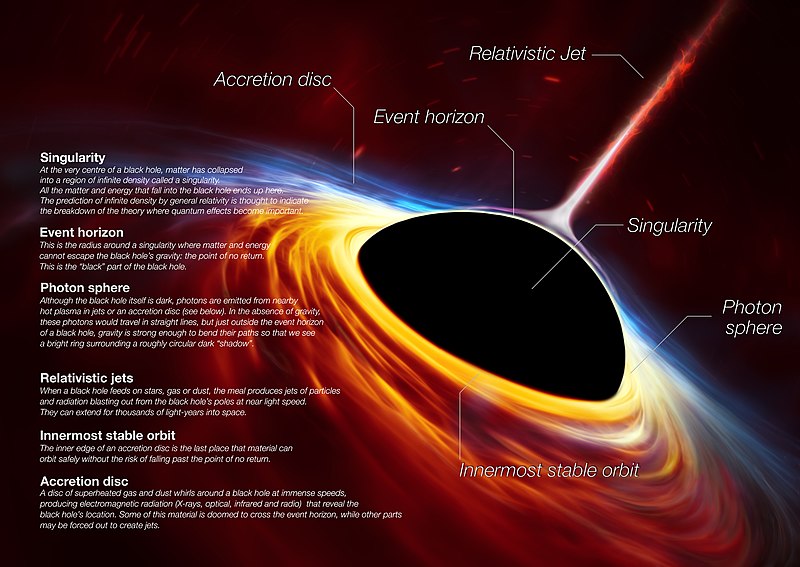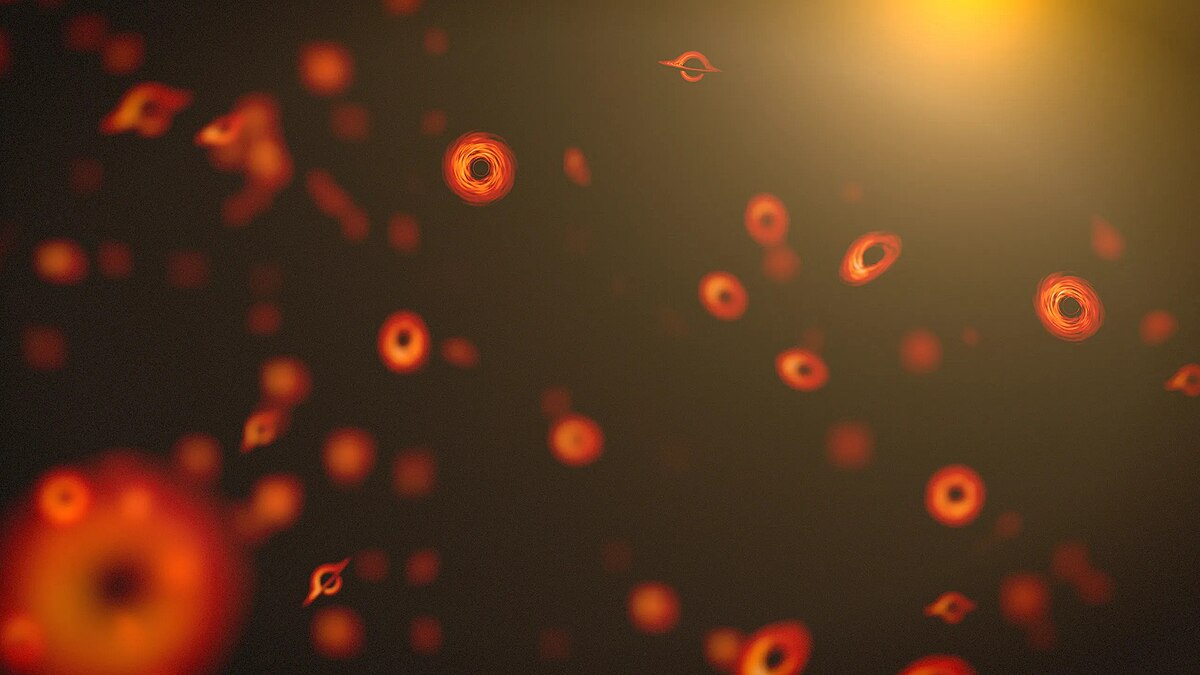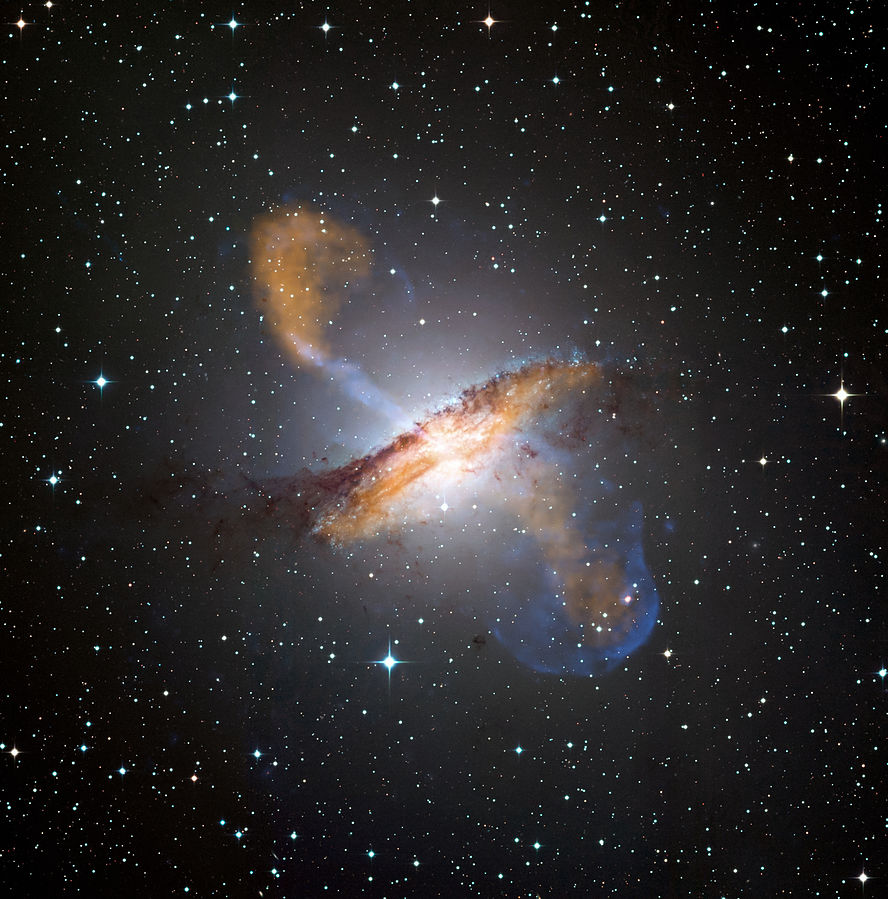
A Black Hole’s photo was revealed in 2019.
A black hole suggests nothingness– a plunge into the territories where the concepts of “space,” “time,” and their collective non-duality of “spacetime” break down. It is a place where the curvature of space and gravity become so extreme that a hole is formed; perhaps “spacetime tears apart” would be the proper way of phrasing it. Writing about black holes is quite a challenge as we don’t really know if we call it a “place” to begin with, as conventions about “place,” “space,” and “time” undergo wild distortions in and around a black hole.
Nonetheless, a black hole is created when a giant star dies in a supernova explosion. These explosions, which are often known as “standard candles” in astronomy, take place after in the lattermost of all lattermost stages of a star’s life. After an enormous star has exhausted all its hydrogen into helium, the helium then into heavier elements such as Carbon and others, and these Carbons and Co. are inevitably converted to iron, the star implodes and creates a black hole.
From our understanding, matter becomes isolated from the rest of space-time when matter falls into its event horizon. For all practical purposes, matter disappears from the universe. This mind-boggling phenomenon has led to different theories by various well-known physicists about what happens to a mass that gets trapped in a black hole. Where do black holes take those objects?

This is an artist’s impression of what a Black Hole would look like. The labeling in the diagrams indicates the various terminologies used in Black Hole physics.
Interesting facts about the Black hole that you might not know
- A black hole can only be identified by the light of the matter that surrounds its event horizon.
- The nearest black holes to Earth are Gaia BH1 and Gaia BH2, which are 1,560 light-years and 3,800 light-years from Earth, respectively.
- The first black hole discovered was Cygnus X-1, which was discovered through X-ray technology.
- Black holes are safe to observe from a lengthy distance as they can’t consume the entire universe- at least for now.
- In the event horizon of a small-sized black hole, the matter gets stretched into a long, thin shape like a noodle.
- The smallest Black Holes can be of the size of an atom.
- The Milky Way harbors a massive black hole known as Sagittarius.
- Black holes can disrupt Time. At the event horizon, Time moves slower than outside the back hole.
- The first image of the Black Hole was captured by the event horizon telescope collaboration in 2019.
Understanding Black Holes
We all heard this cliche: “A black hole is a region of spacetime where gravity is so strong that nothing, including light and other electromagnetic waves, has enough energy to escape.” The theory of general relativity states that sufficient compression of mass can bend space and gravity and create a black hole. If we could compress the Earth to a spherical ball of 9 mm, we would have had a black hole by the name of “the Earth.” Theoretically, any matter of any size can be squished in a quantified “Schwarzschild Radius” to form a Black Hole.

Photo: NASA’s Goddard Space Flight Center | Wikimedia Commons
Size of a Black Hole
A black hole is formed when the balance between radiation and gravity goes wayward. After a sufficiently large-sized star has gravitationally collapsed to form a black hole (depending upon the mass and the size of the star a star might also form a neutron star instead of a Black Hole), it can grow by absorbing mass from its surroundings. Astronomers generally categorize black holes into three types according to their mass: Stellar, Supermassive, and Intermediate-mass.
Stellar
When a star with a mass less than 20 of the sun runs out of fuel and collapses on itself, it forms a stellar mass of a black hole.
Supermassive
A supermassive black hole is present in almost all galaxies. It is found in the center of the galaxy, and they have hundreds of thousands to billions of times the Sun’s mass.
Intermediate
Scientists are puzzled by the gap in mass between stellar and supermassive black holes. They think that there should be a black hole between these extremities and have named it an Intermediate black hole.

Photo: ESO/WFI (Optical); MPIfR/ESO/APEX/A.Weiss et al. (Submillimetre); NASA/CXC/CfA/R.Kraft et al. (X-ray) | Wikimedia Commons
The Journey into a Black Hole
We know, from Einstein’s Theory of Relativity, that gravitational fields bend space and Time when they get near a star or a body with a sufficiently large mass. So when we get close to a black hole, the planets or galaxies behind the black hole would start to look like they are bending around the black hole due to an effect known as gravitational lensing.
Gravitational Lensing
For the sake of simplicity, let us consider a black hole with no charge and which is not sucking up matter. As we approach the black hole, the distortion of the sky grows greater and greater. A large proportion of our field of view will be in darkness.
At the point where half of our field of view is swallowed up by darkness, we reach the photon sphere. At this point, the black hole light neither enters nor leaves the black hole. At this point, light or the photons of light orbit the black hole in a circle around the black hole. Theoretically, if you looked sideways in the photon sphere, you would be able to see the back of your head because the light reflecting off the back of your head would travel around the sphere, which is the black hole, and come right back to your face.

Turning into a noodle inside a Black Hole!
A gravitational field bends not only space but also warps Time. Near a black hole, gravity will be so strong that an observer watching you go into the black hole will see you stop in Time and fade away slowly as you enter the event horizon. But to you, it would look like nothing changed as you continue to go into the black hole. As you get closer to the black hole singularity, the view of the universe will get smaller and smaller until it becomes a single sphere.
After you get closer to the singularity, your body will stretch toward it like a noodle. Scientists call this spaghettification. At this point, the molecules in the body would be ripped into small particles. Many theories suggest different outcomes when the particles get to the singularity.
Where Does a Black Hole Take You?
Wormhole
Albert Einstein and Nathan Rosen first proposed the wormhole theory in 1935. A moving black hole or a spinning black hole creates a wormhole at the center, which links two shapes together, which would be a way to transition across space faster than light. This theory doesn’t violate any of the understandings of science, but it takes advantage of the universe’s dimensions. Theoretically, a wormhole can shorten the distance between two points in space by overlapping the points. A wormhole acts like a tunnel that connects the distances and cuts the travel time.

Two regions that we would normally traverse along the red curve can be connected by a wormhole along the short-cut (the green curve)
Alternate universes
The idea that black holes are the gateways to other universes is a theory that is still speculative and not part of mainstream scientific understanding. Nonetheless, some theorists say that as black holes possess immense gravitational pull, they provide the necessary conditions for the existence of wormholes – shortcuts through space-time that could connect two separate universes. Some state that the Big Bang could be a result of the creation of a black hole from another universe. However, there’s no way we can experimentally or observationally verify this proposition.
Interstellar Travel and Black Holes
In astronautics, there is a theoretical ship known as the Blackhole starship. In theory, this ship can perform intergalactic travel by the use of a black hole as a power source for spacecraft propulsion. The concept of using Black Holes as starships was first introduced in the book Imperial Earth by Sir Arthur Charles Clarke. You can also find a similar idea in the works of Charles Sheffield, who is a physicist and science fiction writer. In this theory, the spinning black hole is used as a power source for the rocket. After a scientific analysis by Louis Crane and Shawn Westmoreland in 2009, they concluded that this theoretical ship was on the edge of possibility. But what problems the quantum gravity effects that are presently unknown will pose is another stumbling block.

Jeffrey S. Lee of Icarus Interstellar states that a typical quantum of radiation from a one-attometer black hole would be too energetic to be reflected; it is not clear that a starship powered by Hawking radiation can be made feasible within the laws of known physics. Govind Menon of Troy University suggests exploring the use of a rotating black hole instead:
“With non-rotating black holes, this is a very difficult thing. We typically look for energy almost exclusively from rotating black holes. Schwarzschild black holes do not radiate in an astrophysical, gamma-ray burst point of view”.
All of these competing analyses point to the fact that further research needs to be done to completely understand the use of black holes as a means of space travel.
Real Observations and Discoveries
Astronomers discovered the very first black hole in 1964 AD through the use of X-rays using the Chandra and Webb space telescopes. NASA’s Swift satellite recently detected a rising tide of high-energy X-rays from a source toward the center of our Milky Way galaxy. The outburst, produced by a rare X-ray nova, announced the presence of a previously unknown stellar-mass black hole. In recent studies, black holes have been seen preferring to consume masses before colliding with each other.
The gravitational waves released by the collision of two black holes can be detected on the Earth. Gravitational waves from a black hole merger event suggest the resulting black hole settled into a stable, spherical shape.
Black holes have also helped us to understand our universe better. They have helped us scrutinize the details of Einstein’s theory of general relativity, and further analysis of these strange objects would tell us much more about this and other rules of the universe.
Black Holes in Popular Culture
Black holes have been depicted in various popular cultures, including movies, TV series, books, comics, etc. These depictions of black holes have made the subject mainstream. One of the best depictions in today’s media is shown in the movie Interstellar.
Black holes have influenced different popular fiction. In a popular anime series, Steins; Gate, they use a revolving black hole to send messages about the past. These are only some examples of the use of the black hole in pop culture and media today. These fictional ideas are only possible because we haven’t clearly understood the properties of the black hole. These gaps in our knowledge leave areas for fictional writing and fictional depiction of the partly unknown black hole.

Kip Thorne, a Black hole physicist who worked closely to covey the idea of a Black Hole to the general public in the movie “Interstellar”.
Mysteries and Unanswered Questions
Even after decades of study, there still remains much mystery and unanswered questions about the black hole. One of the most mysterious areas of the black hole is its singularity. Scientists believe that the laws of physics as we know them break down at the singularity and that our current understanding of the universe is incomplete.
Another mystery is the information paradox. According to the laws of physics, information cannot be destroyed. However, if an object falls into a black hole, its information appears to be lost forever. This paradox has been the subject of many debates among physicists and remains unsolved. It also violates the Law of conservation of mass, which breaks the general understanding of physics.
Another mystery of the black holes is how they have been forming before the Big Bang. In cosmology, primordial black holes are hypothetical black holes that formed soon after the Big Bang. But not much is known about the black holes before the Big Bang.
Conclusion
The nature of the black hole continues to fascinate, bewilder, and perhaps, therefore, intrigue scientists as well as people not involved in scientific research. Though the use of different technologies like telescopes and satellites has helped us unravel some of its mysteries, many of its paradoxes remain unexplained. As we explore the concept of interstellar travel through the use of black holes as fuel sources and as we understand the physics behind well-renowned theories like the wormhole, the true nature of the black hole is still being understood.
Frequently Asked Questions:
What is likely inside a black hole?
A black hole probably has a singularity where the density of matter is infinite. But other theories, like the wormhole theory, suggest that inside the black hole, two spaces connect, and the matter that enters the black hole escapes through a theoretical object like the white hole. Some theories also claim you can travel in Time by entering a black hole.
Does Time stand still inside a black hole?
No, Time doesn’t stop inside the black hole. According to Einstein’s theory of general relativity, gravity wraps spacetime. As an object approaches the Black Hole, anyone outside it would observe the object frozen in Time at the event horizon of the black hole. But the object does traverse inside it. So, Time doesn’t stand still in the black hole, but for the outsider, all information about the object is forever lost.
Is there a bottom to a black hole?
Some posit that there might be a bottom to a black hole, but the bottom is never reached because the black hole wraps spacetime continuously, creating a never-ending pit in the fabric of space. But there are still gaps in this assumption, and the bottom of a black hole is a complex subject that can’t be clearly explained.
Does a black hole have two openings?
No, Black holes don’t have two openings like an ‘in’ and an ‘out’ opening. Instead, black holes have an event Horizon through which matter can enter the black hole. It is also known as the point of no return. But theoretically speaking, black holes can have two mouths or wormholes, which connect a black hole with a ‘white hole.’

The first image of the Black Hole that lies at the center of the Milky Way galaxy.
Do white holes exist?
Mathematically speaking, white holes do have a chance of existing, but most scientists don’t believe in their existence because we have found no proof of any white holes. We know that black holes exist because we have detected gravitational waves rippling across space. We have not found any gravitational anomalies to suggest that white holes exist. So, the answer about the existence of a white hole is open-ended.
Can a black hole turn into something else?
According to modern concepts, Black holes can eventually evaporate and turn into a cloud of radiation in a process called Hawking radiation. Hawking showed that a black hole can evaporate, gradually transforming itself and anything it consumes into a featureless cloud of radiation. During the process, information about what fell into the black hole is lost, violating a sacred principle of physics.
What would happen if a 1mm black hole appeared on Earth?
For simplicity, let us consider a black hole with a constant size that doesn’t move. A 1mm black hole, despite its paltry size, would still have the mass of approximately Mount Everest. Due to the gravitational pull, this small Balck Hole would start consuming in bits and pieces before eventually consuming the entire planet. If the mass of the black hole is strong enough, it can disrupt the orbits of other planets that are closer to the Earth.
What triggers a black hole?
When a massive star dies because it cannot produce enough energy in the form of nuclear fusion to sustain the intricate balance of gravity and radiation, the star implodes on itself. If the star has enough mass, it becomes a black hole, but if it doesn’t, it becomes a neutron star. This is all caused by the build-up of iron in the core of the star. When two elements combine to form another element, then energy is released, but when the combination of elements produces iron, it stops combining because two iron atoms don’t fuse to make other elements. Due to this, iron builds up in the star over Time.
How long can black holes last?
According to general relativity, a black hole can last forever, but according to Hawking’s theory, black holes with the mass of our sun will take octodecillion years to evaporate 0.0000001% of their mass. This means that the black holes will be around even after the last star in the universe has died out. So, if you compare the lives of black holes with the lifetime of stars, one might think that they go on ad infinitum.
Can two black holes combine to form a bigger black hole?
Yes, two black holes can combine to form a bigger black hole. This Event is called binary black hole inspiral. Once they come so close that they cannot escape each other’s gravity, they will merge to become one bigger black hole. Such an event would be extremely violent-so violent that it would shoot gravitational ripples all over the universe and its effects could be detected from Earth. This was the source of the discovery of the gravitational waves.
